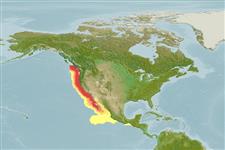Classification / Names
Common names from other countries
Main reference
Size / Weight / Age
Max length : 91.0 cm TL male/unsexed; (Ref. 1371); common length : 60.0 cm TL male/unsexed; (Ref. 1371); max. published weight: 1.2 kg (Ref. 4883); max. reported age: 16 years (Ref. 56527)
Length at first maturity
Lm ?, range 34 - 40 cm
Environment
Marine; brackish; pelagic-neritic; depth range 0 - 1000 m (Ref. 9316), usually ? - 229 m (Ref. 2850)
Climate / Range
Temperate, preferred 14°C (Ref. 107945); 51°N - 15°N, 130°W - 77°W (Ref. 58452)
Distribution
Eastern Pacific: northern Vancouver Island, Canada to northern part of the Gulf of California. A record from the Gulf of Alaska is doubtful.
Countries | FAO areas | Ecosystems | Occurrences | Introductions
Short description
Dorsal
spines
(total): 1;
Dorsal
soft rays
(total): 48-56;
Anal
spines: 0;
Anal
soft rays: 40 - 43. Head rather short. Pectoral fin tips usually reaching to or beyond the origin of anal fin. Caudal fin always concave. Color silvery on back grading to whitish ventrally.
IUCN Red List Status (Ref. 115185)
Threat to humans
Harmless
Human uses
Fisheries: highly commercial
Tools
Special reports
Download XML
Internet sources
Estimates of some properties based on models
Phylogenetic diversity index
PD50 = 0.5000 many relatives (e.g. carps) 0.5 - 2.0 few relatives (e.g. lungfishes)
Trophic Level
4.4 ±0.0 se; Based on diet studies.
Resilience
Medium, minimum population doubling time 1.4 - 4.4 years (tmax=17; tm=4; also Musick et al. 2000 (Ref. 36717))
Vulnerability
High vulnerability (60 of 100)
Price category
